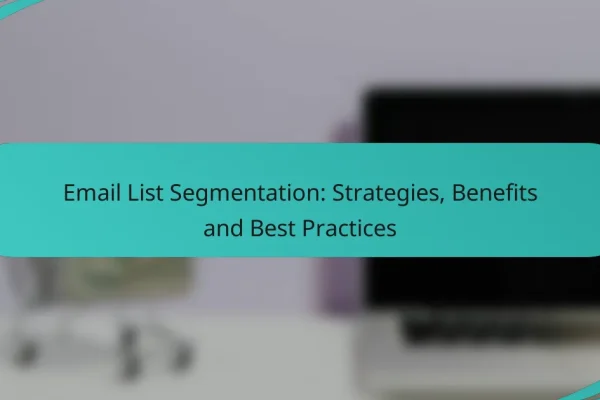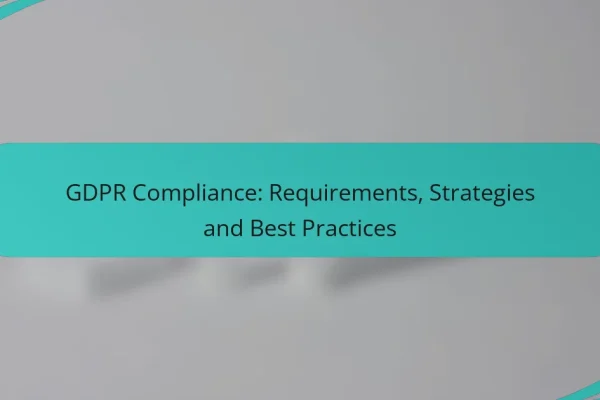
Key Performance Indicators: Definition, Types and Benefits
Key performance indicators (KPIs) are essential metrics that help organizations measure their effectiveness in achieving…
Digital marketing strategies are essential for businesses looking to thrive in today's online landscape. By leveraging techniques such as content marketing, SEO, and social media, companies can effectively engage their target audiences and drive conversions. Understanding your specific goals and audience is crucial in selecting the right approach, ensuring that marketing efforts yield measurable results and enhanced visibility.

Key performance indicators (KPIs) are essential metrics that help organizations measure their effectiveness in achieving key business objectives. By providing valuable insights into progress and performance, KPIs enable companies to make informed decisions, enhance operations, and ultimately drive better outcomes tailored to their specific goals. What are the key performance indicators for businesses in the…

Influencer marketing has emerged as a powerful tool for brands in the UK, providing enhanced visibility, improved audience engagement, and increased trust. By collaborating with influencers who resonate with their target demographics, businesses can create impactful campaigns that drive conversions. Understanding the unique features of platforms like Instagram, YouTube, and TikTok is essential for developing…

Email list segmentation is a powerful strategy that involves dividing your subscribers into distinct groups based on specific criteria. This targeted approach enhances engagement and boosts conversion rates by allowing marketers to tailor their messaging to the unique preferences of each segment. By understanding your audience and categorizing them effectively, you can significantly improve the…

A well-crafted content marketing plan is essential for businesses in the UK to achieve their marketing objectives effectively. By setting clear goals, identifying the target audience, and selecting appropriate channels, companies can create engaging content that resonates with potential customers. This strategic approach not only enhances brand awareness but also drives lead generation and customer…

Blogging plays a crucial role in driving traffic and enhancing SEO for websites, particularly in the UK. By consistently producing high-quality content, businesses can improve their visibility in search engines and engage their audience, fostering a community that encourages interaction and discussion. How does blogging impact traffic in the UK? Blogging significantly boosts traffic in…

GDPR compliance is essential for organizations handling personal data, requiring adherence to strict data protection principles and the rights of data subjects. To achieve compliance, businesses must conduct data audits, establish privacy policies, and implement effective strategies for data protection and transparency. Regular reviews and documentation are crucial for maintaining accountability and avoiding penalties. What…

Negative feedback, while often challenging, presents valuable opportunities for growth and improvement. By acknowledging concerns and responding promptly, organizations can build trust and enhance future interactions. Implementing effective management strategies and fostering a culture of open communication allows businesses to transform criticism into actionable insights, ultimately leading to better customer relationships and operational success. How…

Email subject lines play a crucial role in determining whether your message gets opened or ignored. By crafting concise, engaging, and relevant subject lines, you can effectively capture your audience’s attention and convey the purpose of your email. Understanding common pitfalls and best practices can further enhance your email open rates and overall engagement. What…

In today’s digital landscape, selecting the appropriate social media platform is crucial for effective audience engagement. Each platform, such as Facebook, Instagram, LinkedIn, Twitter, and TikTok, caters to different demographics and offers unique features that can enhance user interaction. By understanding your target audience and aligning your goals with the capabilities of these platforms, you…

To effectively boost Instagram engagement, it is essential to create visually appealing content and maintain a consistent posting schedule while actively interacting with your audience. Utilizing diverse content formats like reels, carousel posts, and live videos can enhance visibility and foster community interaction. By implementing strategies such as collaborations and contests, you can further optimize…
Effective digital marketing strategies in the UK include content marketing, email marketing, social media marketing, search engine optimization (SEO), and pay-per-click advertising (PPC). These approaches help businesses reach and engage their target audiences, driving traffic and conversions through various online channels.
Content marketing focuses on creating valuable and relevant content to attract and engage a specific audience. This can include blog posts, videos, infographics, and podcasts that provide useful information or entertainment.
To succeed, businesses should identify their audience's interests and pain points, then produce content that addresses these needs. Regularly updating content and optimizing it for search engines can enhance visibility and drive organic traffic.
Email marketing involves sending targeted messages to a list of subscribers to promote products, share news, or provide valuable content. It remains one of the most cost-effective strategies for nurturing leads and retaining customers.
To maximize effectiveness, segment your email list based on customer behavior or demographics, and personalize messages accordingly. Regularly analyze open rates and click-through rates to refine your approach and avoid common pitfalls like excessive frequency or irrelevant content.
Social media marketing leverages platforms like Facebook, Twitter, Instagram, and LinkedIn to connect with audiences and promote products or services. Engaging content, such as images, videos, and polls, can foster interaction and build brand loyalty.
Businesses should choose platforms that align with their target demographics and post consistently. Monitoring engagement metrics helps refine strategies and identify which types of content resonate most with followers.
SEO is the practice of optimizing a website to improve its visibility on search engines like Google. This involves on-page elements like keywords, meta tags, and content quality, as well as off-page factors such as backlinks and social signals.
Effective SEO requires ongoing keyword research, technical audits, and content updates. Businesses should focus on providing high-quality, relevant content that answers users' queries while adhering to search engine guidelines to avoid penalties.
PPC advertising allows businesses to display ads on search engines and social media, paying only when users click on their ads. This strategy can drive immediate traffic and is particularly useful for promoting time-sensitive offers.
To optimize PPC campaigns, conduct thorough keyword research, create compelling ad copy, and regularly monitor performance metrics. Setting a clear budget and adjusting bids based on performance can help maximize return on investment while minimizing costs.
Choosing the right digital marketing strategy involves understanding your business goals, audience, and competitive landscape. A well-defined approach ensures that your efforts are aligned with the needs of your target market and can lead to better engagement and conversion rates.
Identifying your target audience is crucial for tailoring your marketing efforts effectively. Start by analyzing demographics such as age, gender, location, and interests to create a detailed customer profile. Tools like Google Analytics and social media insights can provide valuable data.
Consider segmenting your audience into smaller groups based on behavior or preferences. This allows for more personalized marketing messages, which can significantly enhance engagement and conversion rates.
Setting clear objectives is essential for measuring the success of your digital marketing strategy. Use the SMART criteria—Specific, Measurable, Achievable, Relevant, and Time-bound—to define your goals. For example, aim to increase website traffic by 20% over the next three months.
Ensure that your objectives align with your overall business goals. This alignment helps prioritize your marketing activities and allocate resources effectively, maximizing your return on investment.
Analyzing competitors provides insights into effective strategies and market positioning. Start by identifying your main competitors and examining their digital presence, including website performance, social media engagement, and content strategies. Tools like SEMrush or Ahrefs can help in this analysis.
Look for gaps in their strategies that you can exploit. For instance, if competitors are not active on certain social media platforms, this could be an opportunity for you to engage with that audience. Regularly reviewing competitor tactics can keep your strategy relevant and competitive.
Digital marketing strategies offer numerous advantages, including enhanced visibility, improved customer engagement, and measurable results. These benefits help businesses reach their target audiences more effectively and efficiently.
Digital marketing strategies significantly boost brand awareness by leveraging online platforms where potential customers spend their time. Social media, search engines, and email campaigns can help create a strong online presence, making it easier for consumers to recognize and remember a brand.
For instance, consistent branding across social media channels can lead to higher recall rates. Businesses should focus on creating engaging content that resonates with their audience to maximize this benefit.
Implementing effective digital marketing strategies can lead to higher conversion rates, turning potential customers into actual buyers. Techniques such as targeted advertising and personalized email campaigns can significantly enhance the likelihood of conversions.
For example, using A/B testing on landing pages can help identify which elements drive more conversions. Businesses should continually analyze their performance metrics to refine their strategies and improve results.
Digital marketing is often more cost-effective compared to traditional marketing methods. Online advertising platforms allow businesses to set budgets and target specific demographics, ensuring that marketing dollars are spent efficiently.
For instance, pay-per-click (PPC) campaigns can be adjusted in real-time based on performance, allowing businesses to maximize their return on investment. Companies should consider allocating a portion of their marketing budget to digital channels to take advantage of these cost savings.
Digital marketing faces several challenges that can hinder effectiveness, including keeping up with trends, measuring return on investment (ROI), and adapting to algorithm changes. Addressing these issues is crucial for developing successful marketing strategies.
Staying current with digital marketing trends is essential for maintaining a competitive edge. Trends can shift rapidly due to technological advancements and changing consumer behaviors, making it vital to regularly research and adapt strategies accordingly.
For example, the rise of social media platforms or new advertising formats can significantly impact audience engagement. Marketers should subscribe to industry newsletters, attend webinars, and participate in relevant forums to stay informed.
Measuring ROI in digital marketing can be complex, as it involves tracking various metrics across multiple channels. Understanding which metrics to prioritize—such as conversion rates, customer acquisition costs, and lifetime value—is key to evaluating effectiveness.
Using tools like Google Analytics can help marketers assess performance. A good practice is to set clear goals and benchmarks before launching campaigns, allowing for better comparison of results against expectations.
Search engines and social media platforms frequently update their algorithms, which can affect visibility and engagement. Marketers must stay agile and adjust their strategies to align with these changes to maintain their reach.
For instance, a shift in Google's ranking criteria may require a reevaluation of SEO tactics. Regularly reviewing algorithm updates and testing different approaches can help mitigate the impact of these changes on marketing efforts.
Several tools can significantly boost digital marketing efforts by providing insights, streamlining processes, and enhancing communication. Utilizing the right tools can lead to better decision-making and improved campaign performance.
Google Analytics is a powerful tool for tracking website traffic and user behavior. It allows marketers to analyze data such as visitor demographics, traffic sources, and conversion rates, helping to identify what strategies are effective.
To get started, set up an account and integrate the tracking code into your website. Regularly review reports to understand user interactions and adjust your marketing strategies accordingly. Common pitfalls include neglecting to set up goals, which can lead to missed insights on conversions.
Hootsuite is a social media management platform that helps businesses schedule posts, track social media engagement, and analyze performance across multiple channels. This tool is essential for maintaining a consistent online presence and engaging with audiences effectively.
To maximize Hootsuite's benefits, create a content calendar to plan your posts in advance. Monitor engagement metrics to determine the best times to post and adjust your strategy based on audience interactions. Avoid over-scheduling, as it can lead to disengagement from followers.
Mailchimp is an email marketing service that enables businesses to design, send, and analyze email campaigns. It offers automation features, audience segmentation, and performance tracking, making it easier to reach targeted customers effectively.
Start by building a subscriber list and creating engaging email content tailored to your audience's interests. Utilize A/B testing to refine your campaigns and improve open rates. Be cautious of spam regulations, ensuring compliance with laws like the CAN-SPAM Act to maintain a good sender reputation.